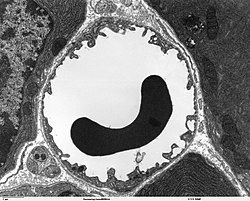Blood capillaries, function, management
Basic Information[edit | edit source]
| Greatness | Value | Brand / Formula |
|---|---|---|
| Length | 750 µm | l |
| Diameter | 3 μm | year |
| Surface | 14,000 μm2 | 2 × π × r × l |
| The surface including the venules participating in the exchange of substances | 25,000 μm2 | |
| Number of capillaries | 40 × 109 | |
| total area | 1000 m2 |
The capillary wall consists of endothelium, basement membrane and only isolated pericytes. Pericytes can regulate vessel lumen. At rest, only 25-35% of capillaries are active. Capillaries are not evenly distributed throughout the body (from 300–400 per mm3 in striated muscles to 2500–3000 per mm3 in the myocardium).
The exchange of gases and substances takes place at the capillary level, the degree of permeability is influenced by the distribution of endothelium. We distinguish three types of layout:
- Continuous endothelial lining,
- fenestrated endothelium - permeable to water and small hydrophilic molecules,
- Discontinuous endothelium - fully permeable to all plasma components.
By filtering the plasma through the capillary wall, tissue fluid occurs.
Links[edit | edit source]
Related Articles[edit | edit source]
References[edit | edit source]
- TROJAN, Stanislav, et al. Medical Physiology. 4th, revised and edited edition. Prague : Grada Publishing, a.s, 2003. 772 pp. ISBN 80-247-0512-5.
- LÜLLMANN-RAUCH, Renate. Histology. 1. edition. Prague : Grada, 2012. 576 pp. ISBN 978-80-247-3729-4.

